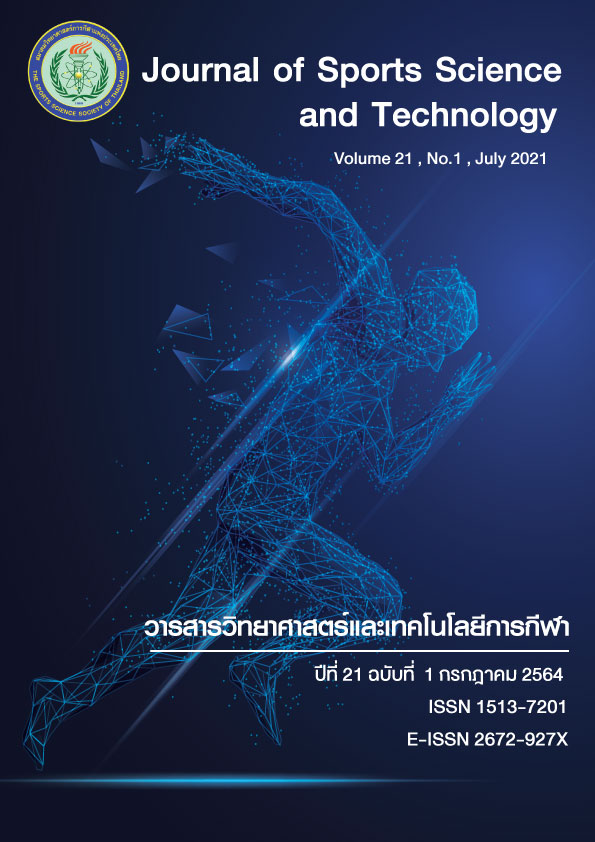COMPARISION BETWEEN THE EFFECTS OF OLYMPIC BARBELL JUMP SQUAT AND HEXAGONAL BARBELL JUMP SQUAT TRAINING ON PEAK POWER, PEAK FORCE, AND PEAK VELOCITY
DOI:
https://doi.org/10.14456/jsst.2021.4Keywords:
KEY WORDS: Olympic barbell jump squat, Hexagonal barbell jump squat, Muscular power developingAbstract
The objective of this research was to study and compare the effects of Olympic barbell jump squat and hexagonal barbell jump squat training on peak power, peak force, and peak velocity in athletes of Thailand National Sports University, Samutsakhon Campus. The samples were divided into 3 groups, Olympic barbell jump squat training group (experimental group 1, N=9), Hexagonal barbell jump squat training group (experimental group 2, N=9) and Regular training group (control group, N=9). They practiced 2 days a week for 6 weeks.
The results from barbell back squat jump test showed significant improvement in peak power, peak vertical ground reaction force, and Peak barbell velocity in the Olympic barbell jump squat training group (p < 0.05), while the Hexagonal barbell jump squat training group significantly improved in peak power, average power, peak barbell velocity and average barbell velocity (p < 0.05). Barbell dead lift squat jump test showed significant improvement in peak vertical ground reaction force, and average vertical ground reaction force in the Olympic barbell jump squat training group (p < 0.05), while the Hexagonal barbell jump squat training group significantly improved peak power, peak barbell velocity, and average barbell velocity (p < 0.05). The effects of Olympic barbell jump squat training and Hexagonal barbell jump squat training on peak power, peak vertical ground reaction force and peak barbell velocity were not statistically significant differences.
Research findings indicate that Hexagonal barbell jump squat training can develop peak power, peak barbell velocity, and average barbell velocity. While Olympic barbell jump squat training can develop peak vertical ground reaction force.
(Journal of Sports Science and Technology 2021; 21(1):45-57)
(Received: 21 December 2020, Revised: 3 March 2021, Accepted: 10 March 2021)
KEYWORDS: Olympic Barbell Jump Squat/ Hexagonal Barbell Jump Squat/ Peak Power/ Peak Force/
Peak Velocity
*Corresponding author: Wipoj CHANSEM
Faculty of Sports and Health Science, Thailand National Sport s University,
Samutsakhon Campus, THAILAND, 74000 E-mail: drwipoj@gmail.com
References
1. Kent M. The Oxford Dictionary of Sports Science and Medicine. Oxford University Press Inc.,
New York; 1994.
2. American College of Sports Medicine. ACSM’s Guidelines for Exercise Testing and Prescription.
9th ed. Baltimore: Williams & Wilkins, inc; 2014.
3. Requena B, Garcia I, Requena F, De Villarreal ES, Cronin JB. Relationship between traditional and ballistic squat exercise with vertical jumping and maximal sprinting. J Strength Cond Res 2011; 25: 2193 – 2204.
4. Fry AC, Kraemer WJ. Physical performance characteristics of American collegate football players. J Appl Sports Sci Res 1991;5(3):126-138.
5. Turner AP, Unholz CN, Potts N, Coleman GS. Peak power, force, and velocity during jump squats in
professional rugby players. J Strength Cond Res 2012;26(6):1594-1600.
6. Swinton PA, Stewart AD, Lloyd R, Agouris I, Keogh IW. Effect of load positioning on the kinematics and
kinetics of weighted vertical jump. J Strength Cond Res 2012;26(4):906 – 913.
7. Lawton TW, Cronin JB, Lindsell RP. Effect of inter-repetition rest intervals on weight training repetition power
output. J Strength Cond Res 2006;20(1):172-176.
8. McBride JM, McCaulley GO, Cormie P. Influence of pre activity and eccentric muscle activity on concentric
performance during vertical jumping. J Strength Cond Res 2008;22(3):750-757.
9. Intiraporn C. Comparison of loaded jump squat training programs on muscular power development in low
relative strength athletes. Bangkok: Sport science faculty Chulalongorn university; 2018.
10. Wilson GJ. Strength and Power in Sport. In J. Bloomfield TR. Ackland B.C. Elliott (eds.) Applied anatomy
and biomechanics. Melbourne Blackwell Scientific Publication. 1994;110 – 208.
11. Turner TS, Tobin DP, Delahunt E. Optimal loading range for the development of peak power output in the
hexagonal barbell jump squat. J Strength Cond Res. 201529(6) : 1627-1632.
12. Malyszek KK, Harmon RA, Dunnick DD, Costa PB, Coburn JW, Brown LE. Comparison of Olympic and
Hexagonal barbells with midthigh pull, deadlift, and countermovement jump. J Strength Cond Res 2016;31(1):140-145.
13. Cormie P, McGuigan MP, Newton RU. Developing maximal neuromuscular power: Part 1
biological basis of maximal power production. Sports Med 2011;41(1):17-38.
14. Haff GG, Nimphius S. Training principles for power. Strength Cond J 2012;34(6):2-12.






